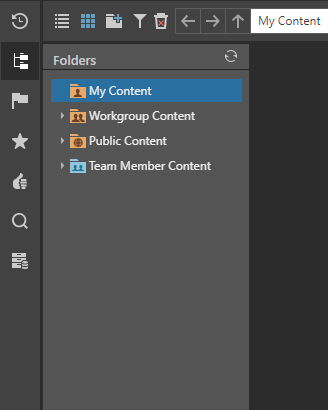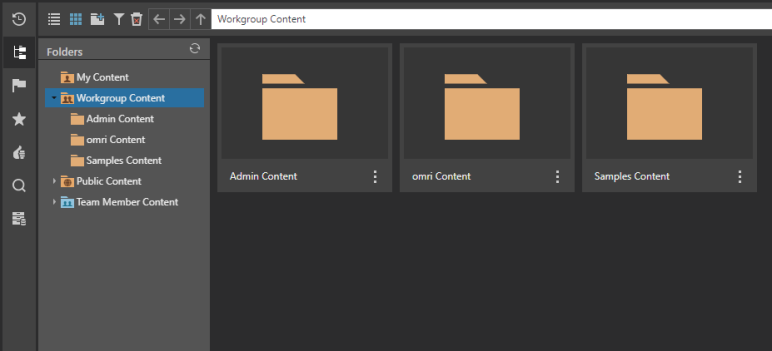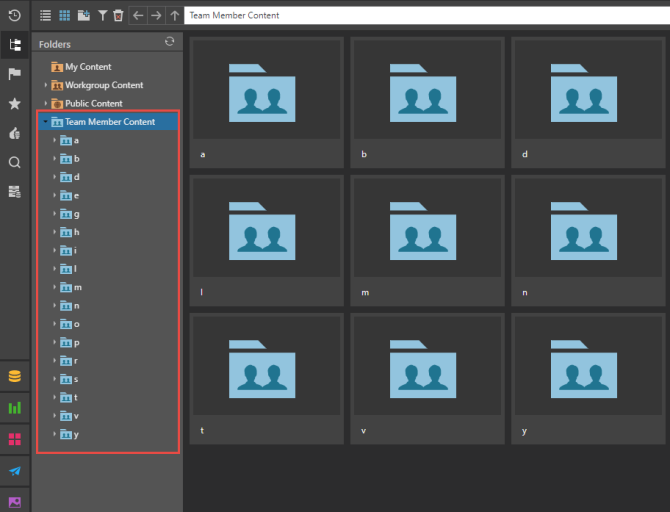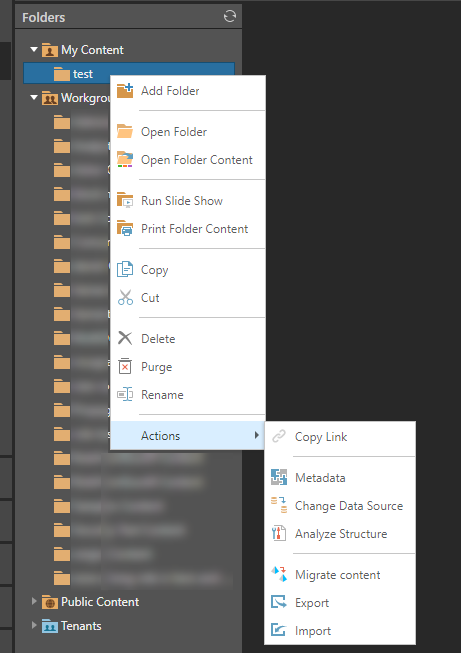The Content Explorer view exposes the content system folder structure to allow users to organize and share content. The folders are broken into 3 sections or "domains" for normal users, with an extra domain for administrators. The folder tree tool also has numerous tools, actions and functions - to allow users to manage and manipulate the organization of content easily.
Content Folder Domains
Folders are broken into 3 domains: My Content, Workgroup Content, and Public Content. Administrators will see an additional folder called Team Member Content.
Beyond the Content Explorer, the folders appear in numerous places throughout the application as described here.

My Content
This is your personal content domain. To keep content private, save it to your My Content folder. Here, pro users are free to create folders and structures unhindered. There is also no need to set roles or security on the content - as everything in this domain remains fully accessible to the current user. This also means that all the content actions and tools are fully operational on this content without restriction.
Content saved to into "My Content" cannot be seen by any other users except admins.
Workgroup Content
This domain is a shared workspace for all users that are members of a given security role. Here, pro users are free to create folders and structures unhindered WITHIN the root folder created for each role. It is perfect for quick sharing of content amongst users of the same security access without the complexity of setting up folder and content security.
Note that all users of the various roles have full read and write access to all content stored in the workgroup space.

Workgroup folder functionality can be limited or turned off. See the following topics for more:
- Blocking Role Specific Workgroup Folders: a switch to prevent a new workgroup folder for each created role.
- Blocking the Workgroup domain for a tenant: a switch to hide the entire workgroup option by tenant.
Public Content
Public content is also a shared workspace like Workgroups. However, role access per folder and content item can be specifically set, providing more granular control of who can do what with the items. Public folder and Item security is captured with 3 "switches":
- As a normal user, your access to public content may be quite limited to READ only rights.
- Others may be given WRITE access to folders, allowing them to change or add content to a folder or an item.
- Separately, certain users may be given MANAGEMENT rights on a folder, which allows them to delegate or change the rights of other roles on the folder or content item.
Administrators, of course, have all rights to all content, all the time.
- Click here for more details on setting role access to content.

Deleted Content Folder
This special folder appears in the public domain and holds all the content from deleted users of the system. It is accessible to admins only, who can elect to move the content back into viewable folders for activated users.
This content is not the same as "deleted content" - which remains in place when normally deleted by users. Such content can be seen by clicking on the deleted content button. The items will appears faded and crossed out throughout the folder tree. These items can be restored by admins unless they are permanently PURGED from the system (also by admins).
Team Member Content for Administrators
Administrators have access to a fourth folder, called Team Member Content. From this folder, Administrators can view the private content of each user in their tenancy. Enterprise admins, can also use this folder to see content across all tenants on the platform.
The functions of the folders and roles within the context of multitenancy are affected by the admin settings for multitenant deployments. Click here for more details on these settings.
 .
.
Folder Actions and Tools
The folder tree in the Context Explorer has a rich set of capabilities triggered through drag-and-drop, right click context menus and the metadata action panel.

Drag-and-Drop Folder Move
If a user left-clicks on a folder and drags it on top of another folder, they effectively MOVE that folder to a new parent folder destination - identical to CUT and PASTE. It is not always available for every folder node in the tree: it will not work on the root domain folders, role folders in Workgroup, or blue tenant folders for admins.
Folder Context Menu
If a user right clicks on a folder, they will be prompted with a context menu (shown above). The functions available include:
- Add Folder: adds a new sub folder to the select folder
- Open Folder: selects the folder and shows its contents in the content panel on the right (equivalent of clicking on the folder node in the tree)
- Open Folder Content: opens all the content items in the folder, launching each as a tab in the App Tab interface.(This does not include content in sub-folders)
- Run Slide Show: Opens all Discover items in "runtime" slide-show mode allowing the user to consume the content without opening each item individually.(This does not include content in sub-folders). This is similar to the App Tab Slide "show" function.
- Print Folder Content: Prints all the Discover and Present content out to the selected document format. This is similar to the App Tab Slide "print open items" function.
- Copy: Copies the content of the folder structure into memory, awaiting the next Paste step, so that is can be copied to a new destination. See Copy / Paste for more.
- Cut: Starts the process of MOVING the selected folder and its contents, by storing the items in memory, awaiting the next Paste step. This is the same as drag-and-drop, but with the convenience of not needing to handle the movements of the mouse. See Cut / Paste for more.
- Delete: This (soft) deletes the folder and all its subordinate content. The items are hidden from view and can be restored by admins.
- Purge: This (hard) deletes the folder and all its subordinate content. The items are fully REMOVED from the system and CANNOT be restored by admins. Only admins can purge content.
- Rename: This is a simple prompt tool to rename the folder. The user must have the right to "write" the change on the folder back to the repository.
- Actions: The actions menu exposes more advanced folder functions and tools.
- Copy Link: This puts a URL link for the selected folder into the clipboard memory that can be pasted to an alternative location. Use the link to provide quick and direct access to a given folder.
- Metadata:this opens the metadata view on the action panel - showing relevant metadata on the selected folder as well as access to other actions and views on the item.
- Roles: This opens the roles panel for the currently selected folder so the user can see the different levels of access for each role set. Since role security can only be changed on Public domain items, this item will only be available on public folders. Further, a user may not be able to change any of the role settings if they do not have management rights on the folder or its parent folder (and usually both).
- Change Data Source: this runs the Data Source Changer (DSC) wizard on all the items in the folder (and sub-folders). Use the DSC to switch the data sources that underlie all data objects from Discover, Formulate, Present etc.
- Analyze Structures: this runs the Structure Analyzer wizard on all the items in the folder (and sub-folders). Use the Structure Analyzer to check the structure of the selected items against the data source to check it has no mismatches or errors.
- Migrate:this runs the Migrate wizard on all items in the folder (and sub-folders). Use the Migrate wizard to move content from one instance of Pyramid to another.
- Export:this manually exports all the items in the selected folder (and sub-folders) into a "PIE" file, which can then be re-imported into another Pyramid instance.
- Import: this manually imports the contents of an existing "PIE" file into the currently selected folder.
The options in the menu change based on the type of folder selected. For example:
- Root Folders and blue tenant folders do not allow copy, cut, delete / purge and rename functions. They also have no designated actions.
- Role folders within workgroup do not allow cut, delete / purge and rename functions. But they do allow copy and have designated actions.
There is a separate set of actions and tools for content items - as distinct from folders - even though many are identical or similar in function and purpose.